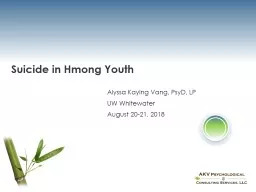

Suicide in Hmong Youth Alyssa Kaying Vang PsyD LP UW Whitewater August 2021 2018 Statistics on suicide Center for Disease Control and Prevention CDC 2nd leading cause of death for youth between ages of 1024 in 2016 up from 3 ID: 771269
Download Presentation The PPT/PDF document "Suicide in Hmong Youth" is the property of its rightful owner. Permission is granted to download and print the materials on this web site for personal, non-commercial use only, and to display it on your personal computer provided you do not modify the materials and that you retain all copyright notices contained in the materials. By downloading content from our website, you accept the terms of this agreement.
Suicide in Hmong Youth Alyssa Kaying Vang , PsyD , LP UW Whitewater August 20-21, 2018
Statistics on suicide: Center for Disease Control and Prevention (CDC) 2nd leading cause of death for youth between ages of 10-24 in 2016 (up from 3 rd place in earlier years) Percentage of youth treated at US children hospitals for suicidal thoughts, suicidal attempts more than doubled from 2008 to 2015 .66% of all visits vs. 1.82% of all visits
Data on Hmong youth and suicide: Asian-American youth are at the greatest risk for developing suicidal behavior and mental health illness (National Asian American Pacific Islander Mental Health Association, 2007) Within the last decade, rate of Southeast Asian youth suicide attempts and completion of suicide have increased. Suicide attempts and completions among Hmong youth in the US have increased significantly but there remains a lack of research (Department of Health and Human Resources, 1999) Hmong youth are 4 times more likely to have suicidal ideation in their lifetime compared to the general population
Hmong youth suicide September 1998 – May 2001: 8 Hmong teens committed suicide Media coverage highlighted the negative consequences of the conflict between the Hmong and American cultures “Lost in America,” Fresno Bee 2002
Risk factors Western: One or more diagnosable mental or substance abuse disorders (e.g., depression, anxiety) Life stressors or losses (e.g., academic demands/pressure, friends, family disruption) Family history of mental or substance abuse disorder Family history of suicide Family violence (e.g., emotional neglect, physical or sexual abuse) Bullying/cyberbullying Prior suicide attempt Firearm in home Hmong: Intergenerational conflict Shame, loss of face Immigration status and acculturation challenges
Cultural beliefs around suicide: Not a social or public health issue Curse on family by ancestors or other spiritual being Mandate in life, visa Reincarnation and the hope for a better life Lifelong suffering and an inability to cross over
Traditional Hmong ways to address suicide: Dealt within family members Spiritual ceremony to prevent this to be passed down to the next generation Health = spiritual and physical components are well Best left unspoken of
Research findings: Depression decreases with higher levels of ethnic identity Ethnic identity and intergenerational conflict are significant predictors of depression Depression and spiritual healing beliefs were predictors of suicide risk, even though risk was low Protective factors: Family cohesion community support trait optimism support from health care community
Future considerations: Start and continue the conversation re: suicide within the framework of mental illness Incorporate both mainstream and Hmong beliefs about suicide in conversations/education Reduce the stigma, shame, etc around depression and suicide while keeping in mind the challenges of suicide in any population
References: Centers for Disease Control and Prevention, CDC 24/7 Saving Lives, Protecting People: Gateway to Health Communication & Social Marketing Practice Jesilow , P. & Xiong , M. Constructing a social problem: suicide, acculturation, and the Hmong, Hmong Studies Journal 8, 1, 2007. Vang , T. The Role of Psycho-sociocultural factors in suicide risk among Mong /Hmong youth, Dissertation, Portland State University, Spring 6-5-2013. Funding for this conference was made possible by NITT-HT grant, CFDA 93.243 from SAMHSA. The views expressed in written conference materials or publications and by speakers and moderators do not necessarily reflect the official policies of the Department of Health and Human Services; nor does mention of trade names, commercial practices, or organizations imply endorsement by the U.S. Government.